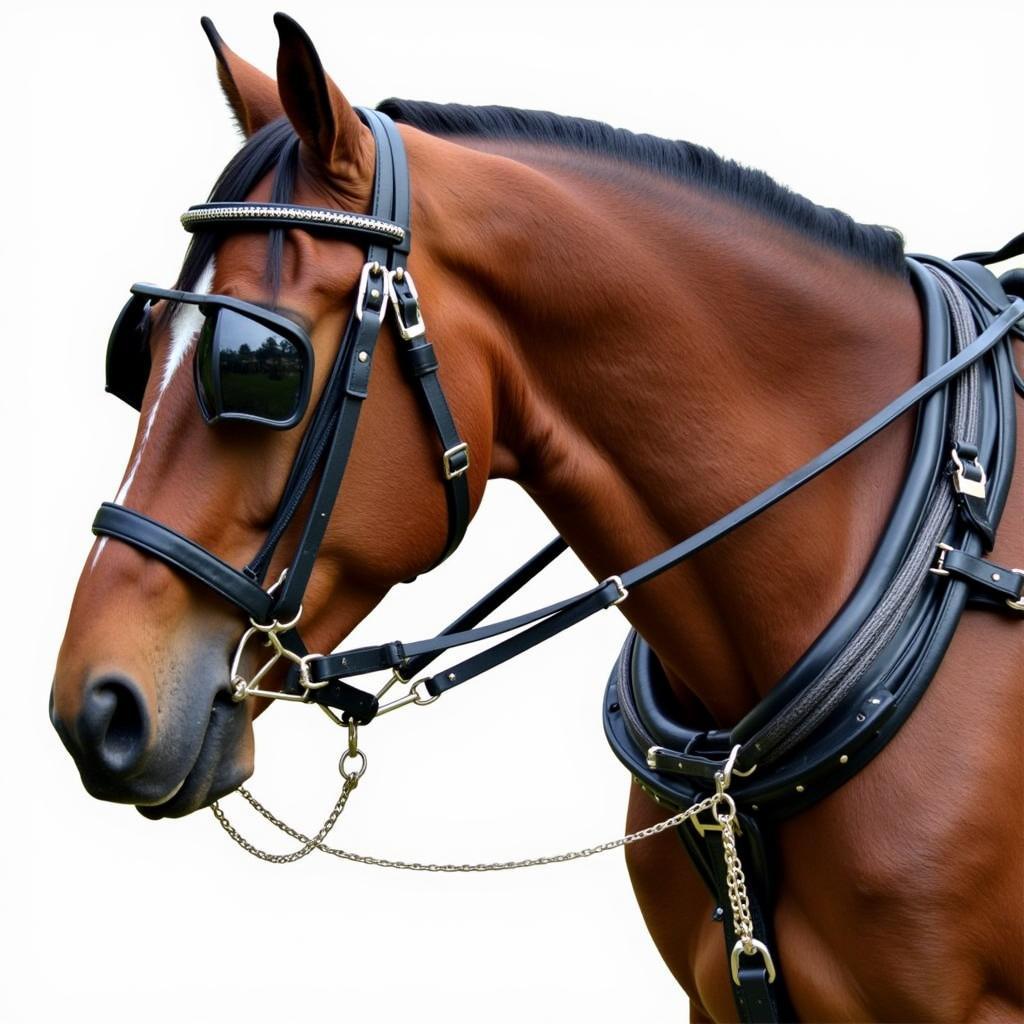Draught Horse Tack requires careful consideration due to the size and strength of these magnificent animals. Selecting the correct equipment ensures both the horse’s comfort and the handler’s safety. This article provides a comprehensive guide to understanding and choosing the appropriate draught horse tack.
Understanding Draught Horse Tack Essentials
Draught horses, known for their impressive power and gentle nature, need tack specifically designed for their build. From collars to harnesses, every piece plays a crucial role in their work and well-being. Choosing the wrong tack can lead to discomfort, injury, and reduced performance. Are you using the correct harness for your thick horse? Let’s explore the key elements of draught horse tack.
 Draught horse harness fitting demonstration
Draught horse harness fitting demonstration
Collars: The Cornerstone of Draught Tack
The collar is arguably the most important piece of draught horse tack. It distributes the weight of the load across the horse’s shoulders and chest, preventing pressure points and allowing them to pull efficiently. Choosing the correct collar involves taking your horse’s shape and build into account, ensuring that they can use their full strength comfortably. Thinking a 17 hands horse might need a specific type of tack? You are right! Size plays a significant role. There are several types of collars, each with its own advantages:
- Full Collars: Traditional and widely used, offering excellent weight distribution.
- Breast Collars: Suitable for lighter work and offer more freedom of movement.
- Dutch Collars: Similar to full collars but with a more upright design.
Hames: Connecting the Collar to the Traces
Hames are the wooden or metal pieces that attach to the collar and connect to the traces. They play a vital role in transferring the pulling force from the horse to the load. Hames should fit snugly against the collar and be properly adjusted to prevent rubbing or pinching.
Traces: The Link Between Horse and Load
Traces are the strong straps or chains that connect the hames to the implement or vehicle being pulled. They should be of appropriate length and strength to handle the load and allow for proper movement. For heavier loads and larger draught horses, consider using thicker, more durable traces.
Fitting and Maintaining Draught Horse Tack
Properly fitted tack is essential for a draught horse’s comfort and safety. Ill-fitting equipment can cause sores, restrict movement, and decrease performance. Regular inspection and maintenance are also crucial.
How to Fit a Draught Horse Collar
Fitting a collar requires expertise. It should sit comfortably on the horse’s shoulders, leaving enough room for two fingers between the collar and the horse’s windpipe. The hames should be adjusted so they don’t pinch or restrict movement. Wondering am I too big to ride a horse of this size? While draught horses are strong, rider weight is a factor.
Cleaning and Care for Draught Horse Tack
Regular cleaning and conditioning of leather tack help preserve its lifespan and prevent cracking. Metal parts should be kept clean and lubricated to ensure smooth operation.
Choosing the Right Draught Horse Tack for Your Needs
Different types of work require different types of tack. Plowing, logging, and driving all have unique demands. Selecting the right equipment ensures both safety and efficiency. Are you using a single or team harness? The number of horses working together will also influence the tack choices.
“A well-fitted harness is like a good pair of shoes – essential for comfort and performance,” says Johnathan Miller, a seasoned farrier with 25 years of experience working with draught horses.
Conclusion
Choosing the right draught horse tack is crucial for the well-being and performance of these powerful animals. Understanding the different components, their functions, and the importance of proper fitting is key to responsible draught horse ownership. Remember to consider the specific needs of your horse and the type of work they will be performing when selecting your tack. Invest in quality draught horse tack for long-lasting performance.
“Investing in quality tack is an investment in your horse’s health and happiness,” adds Amelia Carter, an equine veterinarian specializing in draught horse care.
FAQs
- What type of collar is best for a young draught horse?
- How often should I clean my draught horse tack?
- What are the signs of an ill-fitting collar?
- How do I adjust the hames on my draught horse’s harness?
- What are the different types of traces available for draught horses?
- How can I tell if my draught horse’s tack needs replacing?
- Where can I find a qualified professional to fit my draught horse’s collar?
You might also be interested in our articles on 17 hands horse, am i too big to ride a horse, or thick horse.
For further assistance with your draught horse tack needs, please contact us at Phone: 0772127271, Email: [email protected] or visit us at QGM2+WX2, Vị Trung, Vị Thuỷ, Hậu Giang, Việt Nam. We have a 24/7 customer support team available to help you.